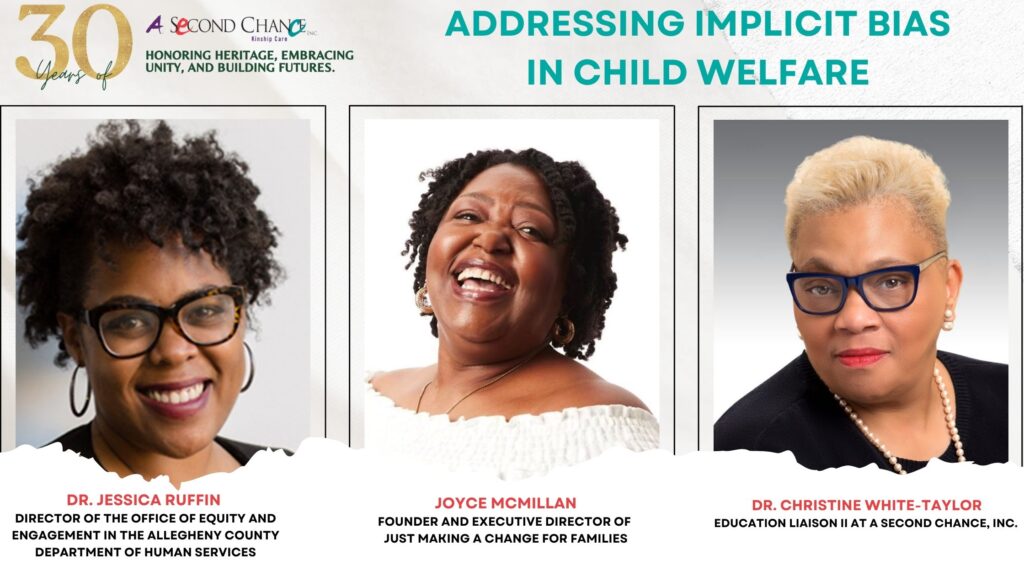Blog
Addressing Implicit Bias in Child Welfare: A Unified Approach to Equity in Education and Child Welfare
Implicit bias is deeply ingrained and influences how we perceive and interact with others, often without our conscious awareness. Dr. Christine White-Taylor, Education Liaison II at A Second Chance, Inc.; Dr. Jessica Ruffin, Director of the Office of Equity and Engagement in the Allegheny County Department of Human Services; and Joyce McMillan, Founder and Executive Director of Just Making a Change for Families (JMACforFamilies), a New York-based organization and the Parent Legislative Action Network (PLAN), discuss how these biases influence child welfare and propose strategies for fostering meaningful change.

What Is Implicit Bias?
Implicit bias consists of subconscious attitudes and stereotypes shaped by our experiences and societal influences. These biases can affect how we perceive others and make decisions. For instance, when asked to picture a nurse, many people might automatically think of a woman, despite knowing that men can be nurses as well. This inherent bias subtly influences our perceptions and interactions.
Dr. Jessica Ruffin illustrates implicit bias through a personal anecdote from her work. She recounts a situation where an agitated client demanded to speak to the “boss.” Jessica, a Black woman, entered the room as the final authority. The client’s surprise—expressed through their comment, “I thought your boss would be a man”— demonstrates how implicit biases can influence expectations and reactions, even in professional settings.
Dr. Christine White-Taylor highlights the persistent issue of implicit bias in education, especially in affluent school districts, where BIPOC students, particularly those in care, are often viewed through a prejudiced lens. Educators and child welfare professionals, who may hold unconscious biases, might disproportionately scrutinize or misinterpret the behavior of BIPOC students, leading to harsher disciplinary actions or increased surveillance.
“When dealing with more affluent school districts, their view of BIPOC students is myopic. They will not fit in and because they are in foster care meaning that they threaten the status of the schools.”
This biased treatment can contribute to a cycle of negative outcomes, such as higher rates of suspensions and referrals to child welfare services, which can further disadvantage BIPOC youth in care and exacerbate existing inequities in their lives. Such biases also lead to assumptions that these students will struggle with attendance, standardized testing, and overall academic performance, compounding the challenges they face and reinforcing systemic disparities. Consequently, “designated school personnel search for information to remove these students from the rolls,” rather than offering the support they need to succeed. Dr. White-Taylor underscores the unfairness of this approach.

The Impact of Implicit Bias on BIPOC Youth
Implicit bias has significant implications for BIPOC youth, particularly in child welfare systems. Dr. Ruffin emphasizes the challenges of distinguishing between neglect and poverty. Indicators such as inadequate food or clothing can sometimes be misinterpreted as neglect rather than signs of poverty. Dr. Ruffin underscores the importance of understanding these nuances, “Instead of defaulting to investigations, workers should consider whether families need access to resources like food banks or clothing programs.”
Joyce McMillan adds another layer to this discussion. She notes that implicit biases can lead to over-reporting and excessive scrutiny of Black and Indigenous families. This increased monitoring in schools can lead to more frequent child welfare interventions, perpetuating systemic inequities and disproportionately impacting these communities.
“Reporters may view Black and Indigenous families with suspicion and interpret behaviors more negatively compared to other families. They often use the mandate as a shield, claiming they had no choice but to report, thereby masking their own biases behind institutional rules.”
McMillan provides a striking example: “A school reported a child to Child Protection Services (CPS) merely because the child’s hair was in dreadlocks. The child’s hair was simply in dreadlocks, but the school reported it as neglect. This reflects a lack of understanding and cultural relevance.” McMillan highlights how such biases can result in harmful, culturally insensitive decisions. Therefore, BIPOC youth, especially those in care, can face a cycle of negative outcomes, including higher rates of suspensions and unwarranted referrals to child welfare services, further intensifying current disparities and deepening the disadvantages they may encounter.
Policy and Practice Improvements

The path to reducing the disproportionate impacts of implicit bias requires ongoing dialogue, collaboration, and systemic change. By engaging with community leaders, prioritizing cultural relevance in training, and reevaluating resource allocation, we can work towards a more equitable child welfare system.
Furthermore, all three advocates agree on the need for a proactive stance against discrimination. Dr. White-Taylor calls for holding individuals who perpetuate bias accountable and taking decisive action to remove them if necessary. Dr. Ruffin’s and McMillan’s insights provide a valuable framework for understanding and addressing implicit bias, emphasizing the importance of cultural relevance and systemic reform.
As McMillan envisions, “Rather than striving for a more equitable child welfare system, I advocate for dismantling the parts that cause harm and replacing them with community-based organizations that support and uplift families without judgment or separation.”
Through committed efforts in training, open dialogue, and systemic reform, we can create educational and child welfare environments that truly support and uplift every child and family, free from the constraints of implicit bias. By persistently advocating for and implementing these changes, we can develop a system that embraces and elevates all families, without judgment or separation.